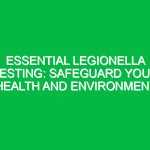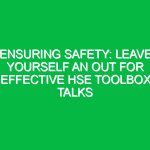Introduction
When it comes to ensuring safety in hazardous environments, the importance of Personal Protective Equipment (PPE) cannot be overstated. Among the various levels of PPE, Level A PPE stands out as the most comprehensive form of protective gear, designed for situations where the highest level of respiratory protection and skin exposure is required. This article delves into the critical role of Level A PPE in the Health, Safety, and Environment (HSE) domain, unpacking its components, applications, and the regulations that govern its use.
Understanding Level A PPE
Level A PPE is used when the hazards are known to pose a significant risk to life or health. This level of protection is essential for environments where airborne substances pose a serious threat, such as chemical spills, biological hazards, or radiological exposure. Typically, Level A PPE includes a fully encapsulating suit, a self-contained breathing apparatus (SCBA), and various other equipment designed to protect against specific hazards.
The Components of Level A PPE
To understand the effectiveness of Level A PPE, it is crucial to explore its components:
- Fully Encapsulating Suit: This suit provides a barrier between the wearer and the hazardous environment, preventing any contaminants from penetrating the fabric.
- Self-Contained Breathing Apparatus (SCBA): This device supplies clean air to the wearer, ensuring they can breathe safely in environments with toxic air.
- Gloves: Chemical-resistant gloves are essential for protecting the hands from hazardous substances.
- Boots: Protective footwear may be included to shield the feet from hazardous materials.
- Communication Equipment: This allows for effective communication in high-risk situations.
Applications of Level A PPE
Level A PPE is utilized in various industries where exposure to dangerous substances is a constant risk. Some common applications include:
- Chemical Manufacturing: Workers handling hazardous chemicals often require Level A PPE to prevent exposure to toxic substances.
- Emergency Response: First responders dealing with chemical spills or biological threats use Level A PPE to protect themselves during operations.
- Laboratories: Facilities dealing with highly infectious agents or dangerous chemicals mandate Level A PPE to ensure the safety of laboratory personnel.
Benefits of Level A PPE
The use of Level A PPE offers several benefits that enhance workplace safety:
- Maximized Protection: Level A PPE provides the highest level of protection against airborne contaminants and skin exposure.
- Improved Confidence: When workers are equipped with the right protective gear, they feel more secure in their roles, which can lead to increased productivity.
- Regulatory Compliance: Utilizing Level A PPE helps organizations comply with health and safety regulations, reducing the risk of legal issues and penalties.
Potential Hazards and Risks
While Level A PPE is designed to protect against serious hazards, it is essential to recognize potential risks associated with its use:
- Heat Stress: Wearing a fully encapsulating suit can lead to overheating, particularly in warm environments. Employers must provide cooling measures and encourage regular hydration.
- Limited Mobility: The bulkiness of Level A PPE can hinder movement and visibility, which may be problematic in emergency situations.
- Improper Fit: If PPE does not fit correctly, it can compromise safety. Regular fitting assessments are crucial.
Best Practices for Using Level A PPE
To ensure the effectiveness of Level A PPE, organizations should follow best practices:
- Training: Employees must receive comprehensive training on the proper use and limitations of Level A PPE.
- Regular Inspections: PPE should be routinely inspected for wear and tear, ensuring that equipment remains functional.
- Emergency Drills: Conducting drills can prepare personnel for scenarios where Level A PPE is necessary, improving response times and effectiveness.
Regulations and Standards Governing Level A PPE
The use of Level A PPE is not just a best practice; it is often mandated by various regulations and standards. Key regulations include:
- OSHA Standards: The Occupational Safety and Health Administration (OSHA) has established standards for the use of PPE in the workplace, including guidelines specific to hazardous materials.
- NIOSH Certification: The National Institute for Occupational Safety and Health (NIOSH) certifies respirators and other protective equipment, ensuring that they meet specific performance criteria.
- ANSI Standards: The American National Standards Institute (ANSI) provides guidelines for the design and performance of PPE, including Level A gear.
Impact of Regulations on Level A PPE
These regulations have a profound impact on how organizations implement Level A PPE. Compliance ensures not only the safety of workers but also the organization’s legal standing. Companies that fail to adhere to these regulations face the risk of fines, legal repercussions, and damage to their reputation.
Real-Life Example: Level A PPE in Action
Consider the case of an emergency response team addressing a chemical spill at a manufacturing facility. Faced with the threat of toxic fumes, the team donned Level A PPE, including SCBA and fully encapsulating suits. Their training enabled them to navigate the hazardous environment effectively, mitigating the risks associated with the spill. By employing Level A PPE, they not only protected themselves but also ensured the safety of nearby residents, highlighting the critical role of proper protective equipment in emergency situations.
Conclusion
Level A PPE represents the pinnacle of personal protective equipment, offering essential protection in the most hazardous environments. Its significance in the HSE domain cannot be underestimated, as it serves to safeguard workers against serious risks to health and safety. By adhering to best practices, staying informed about regulations, and prioritizing training, organizations can effectively implement Level A PPE, ultimately promoting a culture of safety. As we continue to navigate complex workplace hazards, the commitment to utilizing appropriate PPE remains a cornerstone of effective health, safety, and environmental management.


